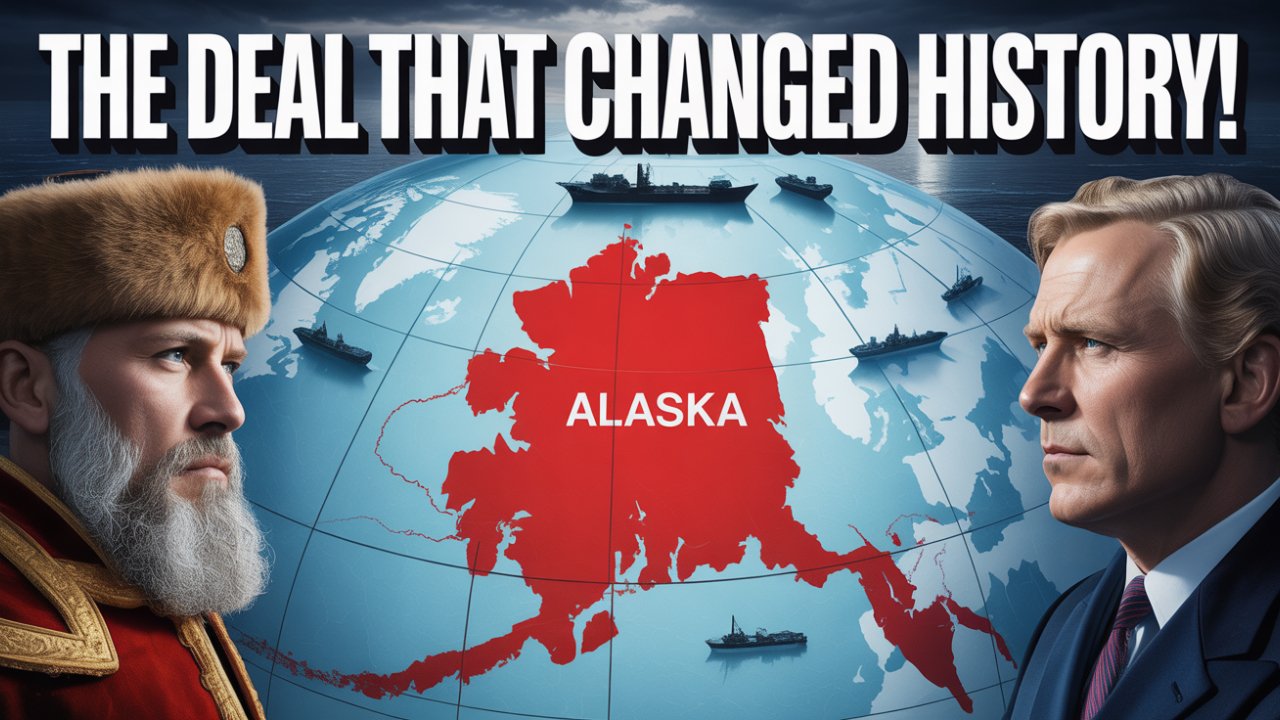Two cents an acre.
That’s what the United States paid for a colossal, frozen wasteland back in 1867. The deal was instantly nicknamed “Seward’s Folly,” seen by many as an absurd purchase of a godforsaken icebox at the top of the world.
Fast forward over 150 years, and that same supposed “folly” is now a geopolitical hotspot, a land of immense strategic value. Its location, just a stone’s throw from Russia, makes it a modern frontier of military vigilance and high-stakes diplomacy.
So how did a ridiculed patch of ice, bought for a pittance from a fading empire, transform into a cornerstone of American power? This is the incredible story of the Alaska Purchase, a journey from a forgotten colonial outpost to the center of the world stage.
Section 1: The Russian Dilemma – An Empire in Retreat
So, why would the Russian Empire ever agree to sell off over half a million square miles of territory? To get that answer, we need to rewind to the mid-19th century, when Russia, under Tsar Alexander II, was an empire in crisis.
The story really starts with a disaster: Russia’s catastrophic defeat in the Crimean War from 1853 to 1856. That war, fought thousands of miles from Alaska, bled the imperial treasury dry and exposed just how far Russia had fallen behind the military and industrial might of Britain and France.
The war left Russia financially shattered. The Tsar and his advisors looked at their vast empire and saw not just strength, but weakness. And no part of that empire felt more vulnerable than Russian America the territory we now call Alaska.
For over a century, Russia had a colonial foothold in North America. It all started in 1725 when Peter the Great sent Vitus Bering to explore the coast. This led to the Russian-American Company, a state-sponsored monopoly set up to govern the territory and exploit its main resource: fur. For decades, the trade in luxurious sea otter pelts was incredibly profitable. But by the 1850s, the sea otters had been hunted to near extinction, and the company’s profits collapsed. While not officially bankrupt, it was a sinking ship, needing more and more money from the already-strained government just to stay afloat.
On top of the economic problems, Alaska was a logistical and military nightmare. It was impossibly remote, what one scholar called “Siberia’s Siberia” hard to supply and even harder to govern from St. Petersburg. There were never more than a thousand Russian settlers there, a tiny presence scattered across a huge wilderness alongside tens of thousands of Indigenous peoples like the Tlingit and Aleut, whose relationship with the colonizers was often full of tension.
But the real fear for the Tsar was the British Empire. Fresh off defeating Russia in Crimea, Britain’s Royal Navy dominated the seas. With a growing presence in what would soon become Canada, British power was right on Alaska’s doorstep. Russian strategists, including the Tsar’s own brother, saw a disaster waiting to happen. In another war with Britain, the Royal Navy could just sail over and seize the territory. Russia’s own Pacific fleet was no match; defending the colony was impossible.
The fear was that Alaska would be lost for nothing. So, a new idea began to form in St. Petersburg: it was better to sell the territory to a friend than lose it to a rival. The United States, a rising power and a rival to Great Britain, was the only real candidate. Russia had floated the idea of a sale back in 1859, but the American Civil War put everything on hold. By 1866, the war was over, and Russia’s mind was made up. Alaska was an unprofitable, indefensible burden. It was time to sell.
Once the decision was made in St. Petersburg, the action shifted to Washington D.C. The man selling the territory was Baron Eduard de Stoeckl, the Russian minister to the U.S. And his counterpart was a man whose name would be forever tied to the frozen north: William H. Seward, the ambitious Secretary of State under President Andrew Johnson.
Seward was a true believer in American expansion, what many called Manifest Destiny. He dreamed of an American republic stretching from the Caribbean to the North Pole. Where others saw a barren wasteland, Seward saw a strategic gateway. He imagined Alaska as a stepping stone for trade with Asia, a home for vital naval bases, and a way to sandwich British Canada between American territories, maybe even leading to its peaceful absorption into the U.S. For Seward, this wasn’t a folly; it was a grand move on the global chessboard.
In March 1867, Stoeckl got his orders from the Tsar: get a deal done, and try to get more than the $5 million that had been discussed earlier.
What happened next was a blur of swift diplomacy. Seward, eager for a win for the embattled Johnson administration, moved incredibly fast. He and Stoeckl started formal talks on March 11th. The popular version of the story is an all-night marathon session. On the evening of March 29th, Stoeckl supposedly called on Seward to say the Tsar had approved the sale. Stoeckl figured they’d finalize things the next day, but Seward, bursting with excitement, insisted they draw up the treaty right then and there.
They woke up their clerks, and worked through the night at the State Department. The story goes they haggled over the price Seward starting at $5 million, Stoeckl holding firm until they landed on $7 million. Then, in a smart move, Seward added another $200,000 to smooth things over, for a grand total of $7.2 million. While the play-by-play of that night is probably exaggerated, the urgency was absolutely real.
At 4 a.m. on March 30, 1867, the treaty was signed. The U.S. had just agreed to buy over 586,000 square miles for about two cents an acre. It was a massive territorial expansion, negotiated in days and sealed in a single night.
Seward knew he still had a political fight on his hands. He took the treaty straight to the Senate and launched a major lobbying campaign, trying to convince skeptical senators of Alaska’s hidden value. He talked about resources, strategic location, and America’s future as a Pacific power. And it worked. On April 9th, just ten days later, the Senate ratified the treaty by a vote of 37 to 2. While the vote looks like a slam dunk, the story of the opposition was just beginning.
This brings us to one of the most famous phrases in American history: “Seward’s Folly.” The popular story we’ve all heard is that everyone the public, the press hated the deal, calling it a colossal waste of money on an “icebox” or a “polar bear garden.” The myth paints Seward as a lone genius, ridiculed by everyone around him.
But the truth is a lot more interesting. While nicknames like “Seward’s Folly” definitely appeared in some newspapers, the idea of universal, overwhelming opposition just isn’t true.
In fact, most major newspapers in 1867 were positive, or at least neutral. Support was especially strong on the West Coast, where people in California and Oregon immediately got the strategic value of controlling the North Pacific. They saw the potential for fishing, timber, and new trade routes to Asia. Even many who weren’t thrilled with the price supported it as a way to check British power in North America. So while some influential papers like Horace Greeley’s New York Tribune were critical, they weren’t speaking for the whole country.
So if the treaty passed the Senate so easily and had decent public support, where did the real trouble come from? The answer wasn’t in the Senate; it was in the House of Representatives. The treaty required the House to approve the $7.2 million to actually pay Russia. And there, the purchase hit a political wall that had almost nothing to do with Alaska.
The House held up the money for more than a year. Why? Because Washington was in chaos. President Andrew Johnson was in a bitter fight with Congress over Reconstruction. In 1868, he was impeached by the House, and the political atmosphere was toxic. The Alaska payment became a political football, used as leverage against both Johnson and Seward.
It was during this long, nasty debate in the House that the “folly” narrative really took hold. To make things even murkier, there have always been rumors of bribery. The story goes that the Russian minister, Stoeckl, got so desperate that he used some of the purchase money to bribe congressmen and journalists to get the payment approved. We have accounts and rumors, but no definitive proof has ever surfaced.
Finally, on July 14, 1868, the House approved the funding. The U.S. Treasury paid Russia, and the deal was officially complete. The funny thing is, the formal handover had already happened months earlier. On October 18, 1867, in a ceremony in Sitka, the Russian flag was lowered, and the American flag was raised. Alaska was already American land; it just took the politicians in Washington another year to pay the bill. That drawn-out political battle is what cemented the myth of “Seward’s Folly” for generations.
So how did this “folly” become one of the greatest bargains in history? We’ll get to that right after this. If you’re enjoying this look at how history shapes our world, make sure you’re subscribed and hit the bell so you don’t miss what’s next.
For the first few decades, Alaska was pretty much what the critics said it was: a remote, ignored, and sparsely populated territory. The Russian settlers left, leaving a small American administration and the lingering influence of the Russian Orthodox Church. It seemed the critics were right. But beneath the ice, the land held secrets that would prove them wrong. Seward himself once said his greatest act was buying Alaska, but that “it will take another generation to find out.” He couldn’t have been more right.
The first clue to Alaska’s true worth came in 1896, with a massive gold discovery in the Klondike region of Canada. Suddenly, Alaska became the highway to the gold fields. Tens of thousands of prospectors poured through Alaskan towns like Skagway and Dyea, turning them into lawless boomtowns overnight.
The Klondike rush put Alaska on the map, but it was just the start. Soon, major gold strikes were made inside Alaska itself in Nome in 1899 and Fairbanks in 1902. The “frozen wasteland” was now a land of opportunity. The gold was just chapter one. The territory was also rich in fish, timber, and copper, which powered its economy for the next 50 years.
But the discovery that changed everything happened much later, on Alaska’s remote North Slope. On March 13, 1968, a company called ARCO struck oil at a place called Prudhoe Bay. And they didn’t just strike oil they hit the largest oil field ever found in North America. The site was estimated to hold about 25 billion barrels of oil in place, with around 12 billion of that considered recoverable. It was a world-changing discovery.
To get that oil to market, one of the world’s great engineering marvels was built: the Trans-Alaska Pipeline. It stretches 800 miles from the Arctic coast to the ice-free port of Valdez, a symbol of human ingenuity in a brutal landscape.
When the oil started flowing in 1977, so did the money. The state, once struggling, was flooded with oil revenue. The wealth was so immense that in 1976, Alaskans voted to create the Alaska Permanent Fund, a state-owned investment fund to save a portion of the oil money for future generations. It was seeded with an initial investment of just $734,000. Through decades of smart investments, by 2025 it had grown to be worth around 80 billion dollars.
Since 1982, earnings from that fund have been paid out every year to nearly every resident as the Permanent Fund Dividend. The oil money effectively got rid of the state income tax and gave citizens an annual check. Seward’s Folly had become Seward’s Fortune, in a way no one could have ever imagined. The $7.2 million purchase price was repaid hundreds and hundreds of times over.
But Alaska’s value isn’t just what’s under the ground. It’s where it is on the map. That same proximity to Russia that was a liability for the Tsar became an invaluable asset for the United States.
This became crystal clear during the Cold War. As tensions with the Soviet Union grew, Alaska became America’s “Guardian of the North.” It was the frontline of defense against a potential Soviet attack over the North Pole. The U.S. poured money into militarizing the territory, building massive air bases and radar stations. The most famous was the DEW Line, a chain of radar sites across the high Arctic designed to detect incoming Soviet bombers. For decades, American jets based in Alaska played a tense cat-and-mouse game, intercepting Soviet planes that probed U.S. airspace over the Bering Strait.
The end of the Cold War seemed to lessen that role, but not for long. Today, Alaska’s geopolitical importance is back, maybe bigger than ever, at the heart of what some call a “New Great Game” for the Arctic. As climate change melts the polar ice, new shipping lanes are opening up that could slash transit times between Asia and Europe. The nations that control those routes will wield enormous power.
Beneath that melting ice lies a fortune in untapped oil, gas, and minerals. Russia, with the world’s longest Arctic coastline, has made dominating the region a top priority, reopening old Cold War bases and deploying new weapons. The U.S. and its allies have noticed. Once again, Alaska is the anchor of America’s strategy in the Arctic a platform for monitoring Russia and asserting U.S. interests.
This brings us to a final, powerful symbol. Imagine a high-stakes summit between an American President and a Russian President. But the location isn’t a neutral city in Europe. It’s Anchorage, Alaska.
So why would a meeting there be so symbolic? Because it embodies every layer of the U.S.-Russia relationship. It’s former Russian territory, a physical reminder of a time when they were neighbors who made the largest peaceful land transfer in history. It’s a bridge, where the two continents are separated by less than three miles of water.
A hypothetical meeting there would be shadowed by today’s tensions. They would discuss arms control, global conflicts, and, most importantly, the future of the Arctic. They’d be forced to confront the new competition for shipping lanes and resources, and the growing military buildup. A meeting on that specific piece of land would be a quiet admission that, despite their rivalry, their shared geography as Arctic nations binds their fates together.
The story of Alaska is an incredible journey. It starts with a Russian Empire, desperate to offload a territory it couldn’t defend. It continues with a visionary American, William Seward, who saw potential where others saw ice, and endured the ridicule for his “folly.”
Then came the vindication. The glitter of gold, the gusher of oil a treasure chest that turned the deal into one of history’s greatest bargains.
And finally, its role on the global chessboard. A Cold War fortress, and now, a critical frontier in the new great game for the Arctic. From “Seward’s Folly” to Seward’s Fortune. From a forgotten icebox to a symbolic meeting ground for world powers. The purchase of Alaska was so much more than a real estate deal. It was a pivot point in history that shaped America’s destiny as a Pacific and Arctic power, and its legacy continues to define the high-stakes geopolitics of our time. It’s a testament to how a perceived folly can, with time, become a nation’s greatest fortune.





